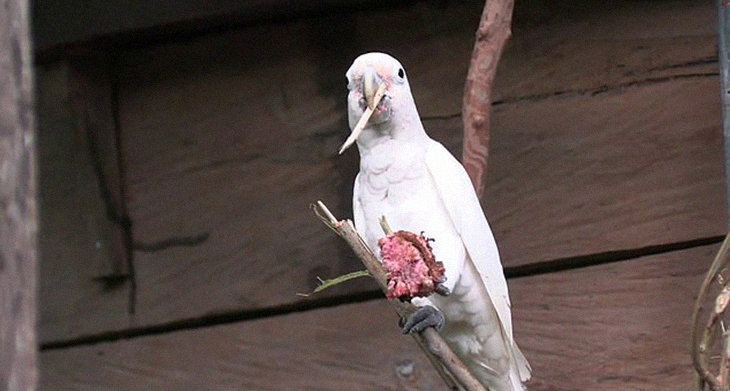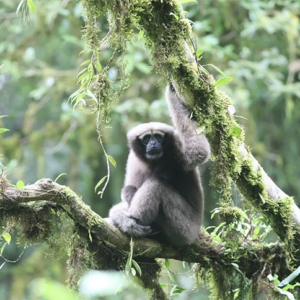
Not all people realize this, but birds are highly intelligent creatures. In fact, a pair of wild Goffin’s cockatoos, which are part of the parrot family, managed to build a whole three-piece set of tools in order to get to the pit of a mango fruit.
These cockatoos were actually caught in the wild and kept in an Indonesian research aviary for some time. While they were there, they were observed and recorded expertly using tools, which proves that this particular kind of bird is considered as one of the avian group’s most clever of all birds.
According to the scientists Mark O’Hara and Berenika Mioduszewska, who happened to be at the research aviary in Tanimbar, an island in Indonesia, when they saw the Goffin’s cockatoos at work.
O’Hara, who is actually from the Messerli Research Institute in Vienna, Austria, told Science, “I’d just turned away, and when I looked back, one of the birds was making and using tools. I couldn’t believe my eyes!”
Notably, before they had managed to capture the wild birds using the tools, O’Hara and Mioduszewska had been watching them for around 900-hours, observing their feeding habits as they sat up high in the canopy, and not once did they ever use any tools. So when they finally managed to see them using the tools, it was a major highlight for the scientists.
There are other bird species such as the Hyacinth Macaw and the New Caledonian Crow that have been witnessed constructing and using stick tools and hook tools as well.
The Goffin’s cockatoos have been observed to be incredibly ‘intuitive social learners’ with the ability to solve tons of different puzzles and problems. At the Messerli Institute, researchers managed to catch one cockatoo teach his fellow birds how to make and use a certain tool as well. Although they share that it was just one tool meant for one particular purpose.
For this new observation, what they saw was considered the first time for any bird species to be seen ‘creating and using a set of tools in a specific order.’
They Call It “The Bird-Brained Bandit”
During the time researchers were observing the cockatoos, the scientists would consistently provide them with food they found on the island such as wawai – otherwise known as sea mango – a fruit that’s considered poisonous for humans but very nutritious for birds. This mango has a hard pit in the center, which protects the rather large, nutritious seed inside of it.
At first, the research team didn’t notice anything extraordinary about the birds they had taken into captivity, that was until two of them began using their talons on the pits. This is when they were discovered to have created not just one or two, but three variations of tools to get their way into the pit of the fruit.
O’Hara explains in a video abstract, “Repeated provisions of the fruit allowed us to analyze the behavior in detail, and to collect and trace some of the manufactured tools.”
He added, “Using a structure-from-motion technique we could create 3D models and gather detailed measurements such as size and volume…[of the tools used]. Based on the physical properties, the function analysis classified three types of tools; we discovered that each tool type seemed to serve a different purpose.”
The birds would take the thicker portion of the branch then use their beak to push and pry open one of the ends of the pit. Then, using the second one – which could be classified as a medium-fine implement or tool – the birds would make a tiny hole in the membrane that enveloped the pit. Then for the last device, they built a scoop-like tool they used with their mouth that allowed them to extract the nutritious seed for them to eat.
Tool making, especially developing sets of tools, is something that has only been observed in capuchin monkeys, chimpanzees, and of course humans. In fact, chimpanzees even use between two to five tools to get into beehives and termite hives.
While this isn’t the first time the parrot lineage has been observed to use tools, the scientists also share that it could possibly be a learned ability due to captivity. Research team O’Hara and Mioduszewska talk about whether this behavior is something only done in captivity or whether tool use is also done in the wild in their research paper published in Cell.
O’Hara also told Science, “If they had a genetic predisposition to use tools, all the birds would do it.”
He added, “Since only a few make these, it’s more likely they invented them independently,” something he claims is probably more likely since it was these two individual birds that had quick and major proficiency in using the tools.
What the researchers believe is that this skill is not a species-wide ability, but that this was acquired by these individuals birds due to either ‘opportunistic innovations’ or possibly by observing and learning from others. Others interesting observations that are shared it the “Discussion Section” of the paper is how the tools that were crafted were specially made knowing the specific purpose and not in a trial-and-error manner.
Moreover, the researchers also share that around the Indonesian island, they found fruit underneath the wawai-bearing trees which looked like they had already been foraged or worked on with tools. In fact, one of them already had a piece of wooden fragment pushed into the fissure of the pit, which they claim that should enough time go by, it could already be considered the first-ever “avian-archaeology” instance in history.
See the video of the birds using their tools here.
What are your thoughts? Please comment below and share this news!
True Activist / Report a typo


